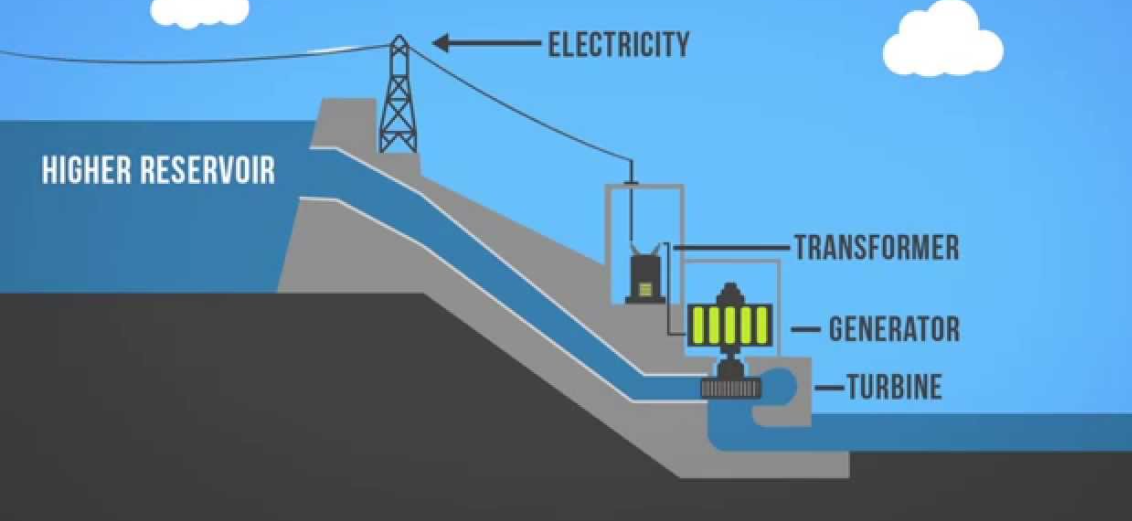Hydropower is the usage of water to operate machines or generate electricity. Water is in a constant state of movement through a huge global cycle: it is evaporated [1] from lakes and oceans, it forms clouds, it drops as rain or snow, and then it returns to the sea. The energy of this water cycle, which is powered by the sun, can be drawn on to generate electricity or for such mechanical tasks as the milling of grain [2]. Hydropower uses a source of fuel water [3], that is not reduced or used up in the process. Because the water cycle is an infinite, ever-renewing system, hydropower is classified as renewable energy.
If running water is captured and transformed into electricity, it is referred to as hydropower or hydroelectricity. There are various types of hydropower plants, they are all powered by the kinetic energy of flowing water as it moves downstream. Turbines and generators turn the energy into electricity, which is then fed into the power grid [4] for use in households, companies and industries.
Types of hydropower and dams
There are different kinds of hydroelectric power plants [5], all of these are powered by the kinetic energy of flowing water as it moves downstream. Dams are used to generate a head of water and store it for use when required. About 75% of the world's existing 45'000 large dams were built for the purpose of flood control, for irrigation [6], for navigation, and for urban water distribution, while approximately 25% of the large reservoirs are used for hydropower and as multipurpose storage.
Run-of-river (abbreviated ROR) power, involves little or no water storage as well as damming. In the absence of water storage, the power plant is subject to seasonal river flows and therefore is operated as an intermittent power source. To be a ROR, the ordinary river flow is not changed too much in any way. They are usually small plants and have a minimal environmental impact.
Pumped-storage hydropower (PSH) is a way of turning excess electrical energy into stored energy by pumping water vertically into a storage pond for future use. It is primarily used by electric power systems for load balancing. Surplus [7] power during off-peak periods is used to pump water from a lower-lying reservoir to a higher-lying one.
Reservoir hydroelectricity [8] is the most widespread type of hydroelectric power plant which uses a artificial dam on a river to retain water in a reservoir. The water that flows out of the reservoir passes through a turbine that spins it, which in turn turns a generator to generate electricity. It is this damming of the river to form a reservoir which is responsible for most of the environmental damage.

Example of a hydropower plant
The impacts of dams
Damming rivers [9], whether for flood control, hydropower generation, irrigation, water storage or navigation, causes enormous environmental damage. The most obvious impact is on local flora and fauna, but there are also negative consequences for people and the planet through increased greenhouse gas emissions, displacement of local populations, earthquakes, and it can even go so far as to affect the Earth's rotation.
Fish
Many fish species migrate upstream to reproduce, and have done so for hundreds of thousands of years. Their migration route is blocked by dams, often resulting in a sharp decline in the number of fish or even extinction [10] of the species. The standard solution is to install fish ladders that allow fish to jump from pond to pond. However, developing the right technique to attract the fish is complicated, while finding a good location is often very difficult.
Climate change
Climate change brings additional uncertainties for hydropower plants. Changing precipitation patterns [11] and prolonged droughts [12] make it difficult to estimate future river flows, which can lead to power supply problems. In addition, the increasingly frequent storms we are experiencing as a result of accelerated [13] climate change can make dams unsafe.
Displacement
The Three Gorges Dam in China required the relocation of 1.3 million people from 1'600 villages and 13 towns to allow the flooding of the region. NASA scientists have calculated that at 600 km long, this massive volume of impounded water actually slows the Earth's rotation by 0.06 microseconds per day.
Quiz question
How long did it take to build the world's largest hydroelectric power plant "three gorges dam" in China?
(Guess and comment below, at the end of this post you can check the solution :D)
A) 21 years
B) 9 years
C) 13 years
Vocabulary
[1] evaporated = verdampft
[2] milling of grain = Mahlen von Getreide
[3] fuel water = Treibstoffwasser
[4] power grid = Stromnetz
[5] power plants = Wasserkraftwerke
[6] irrigation = Bewässerung
[7] surplus = Überschüssig
[8] reservoir hydroelectricity = Stauseewasserkraft
[9] damming rivers = Das Aufstauen von Flüssen
[10] extinction = Auslöschung
[11] precipitation patterns = Niederschlagsmuster
[12] prolonged droughts = anhaltende Dürreperioden
[13] accelerated = beschleunigten
Sources
How green is hydropower? (sustaineurope.com)
List of illustrations
Example of a hydropower plant (mwebantu.news)
Solution to our quiz
The entire construction period of this hydroelectric power plant lasted 13 years.
Kamanya & Karishma